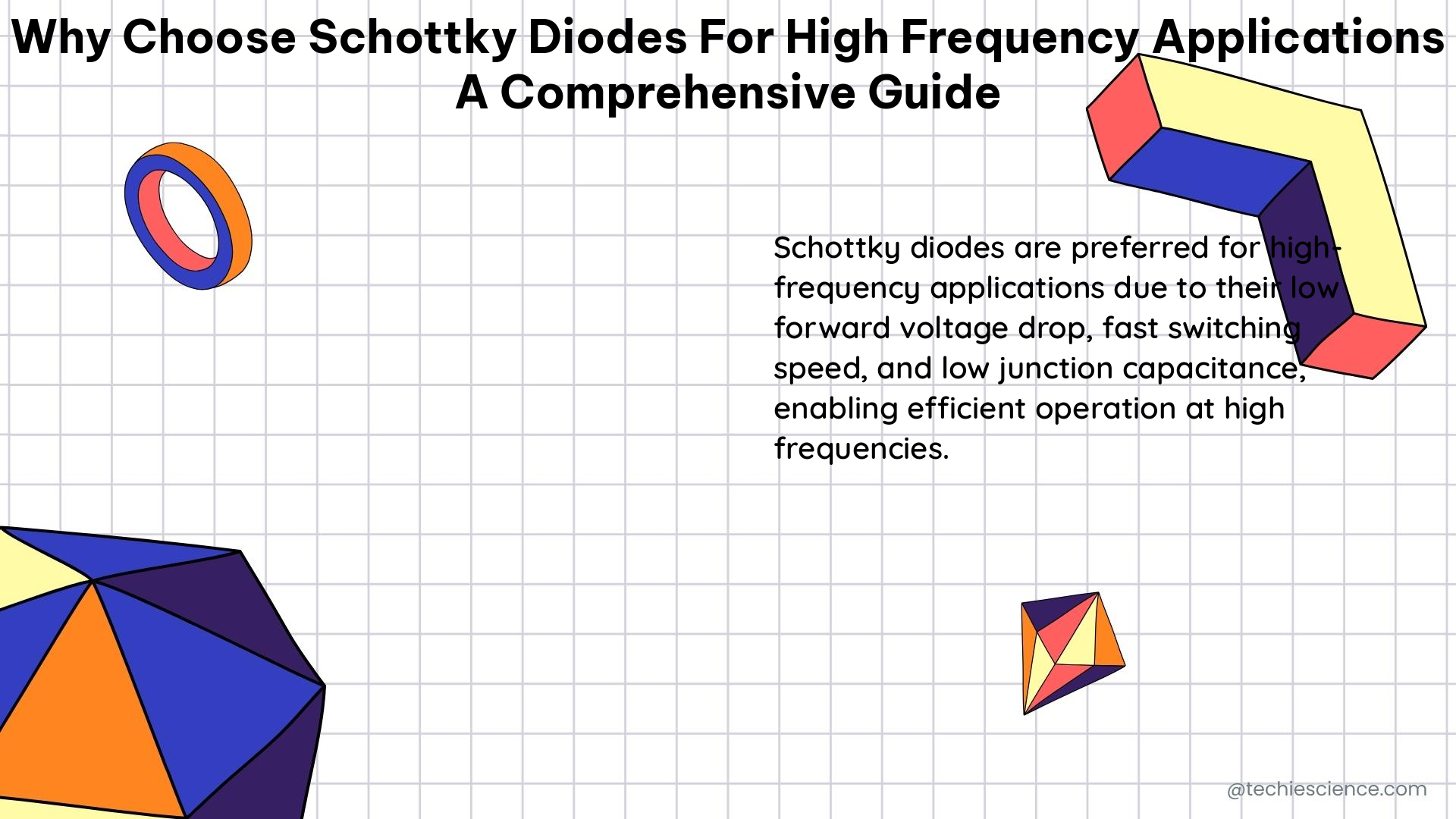Schottky diodes are a popular choice for high-frequency applications due to their unique characteristics and advantages over traditional diodes. These semiconductor devices offer superior performance in terms of lower forward voltage drop, faster switching speeds, higher frequency operation, lower reverse recovery time, and reduced noise generation, making them an ideal choice for a wide range of high-frequency circuits and systems.
Lower Forward Voltage Drop
One of the primary advantages of Schottky diodes is their lower forward voltage drop, typically ranging from 0.2 to 0.4 volts, compared to traditional p-n junction diodes, which have a forward voltage drop of 0.6 to 0.7 volts. This lower voltage drop translates to reduced power losses and improved energy efficiency, which is crucial in high-frequency applications where minimizing power consumption is a critical factor.
For example, the Wolfspeed CPW4-1200-S008B Schottky diode has a maximum forward voltage drop of 0.85 volts at a forward current of 8 amps, while the Wolfspeed CPW4-1200-S002B Schottky diode has a maximum forward voltage drop of 0.65 volts at a forward current of 2 amps. These low forward voltage drops contribute to the high efficiency of Schottky diodes in high-frequency applications.
Faster Switching Speeds

Schottky diodes exhibit faster switching speeds due to their lower junction capacitance. The metal-semiconductor junction in Schottky diodes results in a lower capacitance, enabling faster switching times and reducing the risk of signal distortion at high frequencies.
The switching speed of a diode is typically measured by its reverse recovery time, which is the time it takes for the diode to transition from the forward-biased state to the reverse-biased state. Schottky diodes have a much shorter reverse recovery time, typically in the range of 10 to 100 nanoseconds, compared to hundreds of nanoseconds for traditional diodes.
For instance, the Wolfspeed CPW4-1200-S008B Schottky diode has a typical reverse recovery time of 35 nanoseconds, while the Wolfspeed CPW4-1200-S002B Schottky diode has a typical reverse recovery time of 25 nanoseconds. These fast switching speeds allow Schottky diodes to operate at much higher frequencies without compromising signal integrity.
Higher Frequency Operation
Due to their faster switching speeds and lower junction capacitance, Schottky diodes can operate at much higher frequencies than traditional diodes. Schottky diodes can handle frequencies up to several gigahertz (GHz), making them suitable for a wide range of high-frequency applications, such as:
- Radio frequency (RF) circuits
- Microwave systems
- Satellite communications
- Radar systems
- High-speed digital circuits
For example, the Wolfspeed CPW4-1200-S008B Schottky diode has a maximum operating frequency of 2 GHz, while the Wolfspeed CPW4-1200-S002B Schottky diode has a maximum operating frequency of 3 GHz. These high-frequency capabilities allow Schottky diodes to be used in applications where traditional diodes would not be able to perform effectively.
Lower Reverse Recovery Time
Schottky diodes have a much shorter reverse recovery time compared to traditional diodes. The reverse recovery time is the time it takes for the diode to transition from the forward-biased state to the reverse-biased state, and it is a critical parameter in high-frequency applications.
A shorter reverse recovery time reduces the risk of signal distortion and interference, making Schottky diodes ideal for high-frequency circuits where signal integrity is crucial. The typical reverse recovery time for Schottky diodes ranges from 10 to 100 nanoseconds, while traditional diodes can have reverse recovery times in the hundreds of nanoseconds range.
For instance, the Wolfspeed CPW4-1200-S008B Schottky diode has a typical reverse recovery time of 35 nanoseconds, and the Wolfspeed CPW4-1200-S002B Schottky diode has a typical reverse recovery time of 25 nanoseconds. These fast reverse recovery times contribute to the superior high-frequency performance of Schottky diodes.
Lower Noise Generation
Schottky diodes generate less noise than traditional diodes due to their lower junction capacitance and faster switching speeds. This reduced noise generation is particularly important in high-frequency applications where the signal-to-noise ratio is a critical factor, as it ensures better signal quality and reliability.
The lower noise generation of Schottky diodes is achieved through their unique metal-semiconductor junction, which results in a lower capacitance and faster switching times. This, in turn, reduces the amount of noise and interference generated by the diode, making it an ideal choice for high-frequency circuits and systems that require a high signal-to-noise ratio.
For example, the Infineon RF Schottky Diodes datasheet highlights the low noise characteristics of these devices, stating that they exhibit a typical noise figure of less than 6 dB at 1 GHz, which is significantly lower than traditional diodes.
Conclusion
In conclusion, Schottky diodes offer a range of measurable, quantifiable advantages that make them the preferred choice for high-frequency applications. Their lower forward voltage drop, faster switching speeds, higher frequency operation, lower reverse recovery time, and reduced noise generation contribute to their superior performance in high-frequency circuits and systems.
By understanding the technical details and specific data points that highlight the advantages of Schottky diodes, electronics engineers and designers can make informed decisions when selecting the most appropriate semiconductor devices for their high-frequency applications.
References
- Wolfspeed: 1200V Bare Die Silicon Carbide Schottky Diodes Gen4 – CPW4-1200-S008B
- Wolfspeed: 1200V Bare Die Silicon Carbide Schottky Diodes Gen4 – CPW4-1200-S002B
- RFMW: Schottky Diode Guide
- Ultra Librarian: Schottky Diode Datasheet Explained
- Infineon: RF Schottky Diodes Product Brief

The lambdageeks.com Core SME Team is a group of experienced subject matter experts from diverse scientific and technical fields including Physics, Chemistry, Technology,Electronics & Electrical Engineering, Automotive, Mechanical Engineering. Our team collaborates to create high-quality, well-researched articles on a wide range of science and technology topics for the lambdageeks.com website.
All Our Senior SME are having more than 7 Years of experience in the respective fields . They are either Working Industry Professionals or assocaited With different Universities. Refer Our Authors Page to get to know About our Core SMEs.